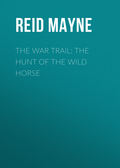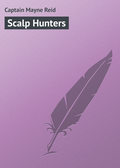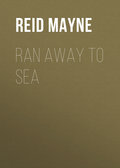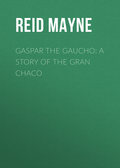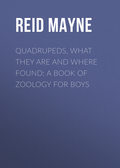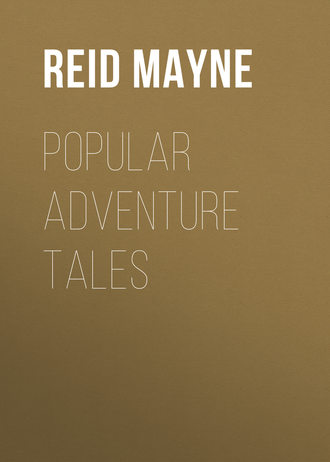
Майн Рид
Popular Adventure Tales
CHAPTER XLIX.
THE MANATI
The araguatoes, with dried plantains and cassava, were the food of our travellers for several days after. On the evening of the third day they had a change. Guapo succeeded in capturing a very large turtle, which served for relish at several meals. His mode of taking the turtle was somewhat curious, and deserves to be described.
The balza had been brought to the bank, and they were just mooring it, when something out on the water attracted the attention of Leon and Leona. It was a small, darkish object, and would not have been observed but for the ripple that it made on the smooth surface of the river, and by this they could tell that it was in motion.
“A water-snake!” said Leon.
“Oh!” ejaculated the little Leona, “I hope not, brother Leon.”
“On second thoughts,” replied Leon, “I don't think it is a snake.”
Of course the object was a good distance off, else Leon and Leona would not have talked so coolly about it. But their words had reached the ear of Doña Isidora, and drawn her attention to what they were talking about.
“No; it is not a snake,” said she. “I fancy it is a turtle.”
Guapo up to this had been busy with Don Pablo in getting the balza made fast. The word “turtle,” however, caught his ear at once, and he looked up, and then out on the river in the direction where Leon and Leona were pointing. As soon as his eye rested upon the moving object he replied to the remark of Doña Isidora.
“Yes, my mistress,” said he, “it is a turtle, and a big one too. Please all keep quiet – I think I can get him.”
How Guapo was to get the turtle was a mystery to all. The latter was about thirty paces distant, but it would be difficult, if not impossible, to hit his small snout – the only part above water – with the arrow of the blow-gun. Moreover, they thought that the arrow would not penetrate the hard, bony substance, so as to stick there and infuse its poison into the wound.
These conjectures were true enough, but his gravatána was not the weapon which Guapo was about to use. He had other weapons as well – a fish-spear or harpoon, and a regular bow and arrows, which he had made during his leisure hours in the valley.
The latter was the weapon with which the tortoise was to be killed.
Taking the bow, and adjusting an arrow to the string, Guapo stepped forward to the water's edge. All watched him, uttering their hopes of his success. It was still not clear with them how the turtle was to be killed by an arrow shot from a bow any more than by one sent from a blow-gun. Would it not glance from the shell even should he succeed in hitting it under water! Surely it would!
As they stood whispering their conjectures to one another, they observed Guapo, to their great astonishment, pointing his arrow upward, and making as if he was going to discharge it in the air! This he, in fact, did do a moment after; and they would have been puzzled by his apparently strange conduct, had they not observed, in the next instant, that the arrow, after flying high up, came down again head-foremost and stuck upright in the back of the turtle!
The turtle dived at once, and all of them expected to see the upright arrow carried under water. What was their surprise as well as chagrin to see that it had fallen out, and was floating on the surface! Of course the wound had only been a slight one, and the turtle would escape, and be none the worse for it.
But Guapo shared neither their surprise nor chagrin. Guapo felt sure that the turtle was his, and said nothing; but, jumping into the canoe, began to paddle himself out to where the creature had been last seen. What could he be after? thought they.
As they watched him, they saw that he made for the floating arrow. “Oh!” said they, “he is gone to recover it.”
That seemed probable enough, but, to their astonishment, as he approached the weapon it took a start, and ran away from him! Something below dragged it along the water. That was clear, and they began to comprehend the mystery. The head of the arrow was still sticking in the shell of the turtle. It was only the shaft that floated, and that was attached to the head by a string! The latter had been but loosely put on, so that the pressure of the water, as the turtle dived, should separate it from the shaft, leaving the shaft with its cord to act as a buoy, and discover the situation of the turtle.
Guapo, in his swift canoe, soon laid hold of the shaft, and after a little careful manœuvring, succeeded in landing his turtle high and dry upon the bank. A splendid prize it proved. It was a “jurara” tortoise – the “tataruga,” or great turtle of the Portuguese, and its shell was full three feet in diameter.
Guapo's mode of capturing the “jurara” is the same as that generally practised by the Indians of the Amazon, although strong nets and the hook are also used. The arrow is always discharged upwards, and the range calculated with such skill, that it falls vertically on the shell of the turtle, and penetrates deep enough to stick, and detach itself from the shaft. This mode of shooting is necessary, else the jurara could not be killed by an arrow, because it never shows more than the tip of its snout above water, and any arrow hitting it in a direct course would glance harmlessly from its shell. A good bowman among the Indians will rarely miss shooting in this way, – long practice and native skill enabling him to guess within an inch of where his weapon will fall.
In the towns of the Lower Amazon, where turtles are brought to market, a small square hole may be observed in the shells of these creatures. That is the mark of the arrow-head.
Guapo lost no time in turning his turtle inside out, and converting part of it into a savoury supper, while the remainder was fried into sausage-meat, and put away for the following day.
But on that following day a much larger stock of sausage-meat was procured from a very different animal, and that was a “cow.”
“How?” you exclaim, – “a cow in the wild forests of the Amazon! Why, you have said that no cattle – either cows or horses – can exist there without man to protect them, else they would be devoured by pumas, jaguars, and bats. Perhaps they had arrived at some settlement where cows were kept?”
Not a bit of it; your conjecture, my young friend, is quite astray. There was not a civilised settlement for many hundreds of miles from where Guapo got his cow – nor a cow neither, of the sort you are thinking of. But there are more kinds of cows than one; and, perhaps, you may have heard of a creature called the “fish-cow?” Well, that is the sort of cow I am speaking of. Some term it the “sea-cow,” but this is an improper name for it, since it also inhabits fresh-water rivers throughout all tropical America. It is known as the Manati, and the Portuguese call it “peixe boi,” which is only “fish-cow” done into Portuguese.
It is a curious creature the fish-cow, and I shall offer you a short description of it. It is usually about seven feet in length, and five round the thickest part of the body, which latter is quite smooth, and tapers off into a horizontal flat tail, semicircular in shape. There are no hind-limbs upon the animal, but just behind the head are two powerful fins of an oval shape. There is no neck to be perceived; and the head, which is not very large, terminates in a large mouth and fleshy lips, which are not unlike those of a cow: hence its name of “cow-fish.” There are stiff bristles on the upper lip, and a few thinly scattered hairs over the rest of the body. Behind the oval fins are two mammæ, or breasts, from which, when pressed, flows a stream of beautiful white milk. Both eyes and ears are very small in proportion to the size of the animal, but, nevertheless, it has full use of these organs, and is not easily approached by its enemy.
The colour of the skin is a dusky lead, with some flesh-coloured marks on the belly, and the skin itself is an inch thick at its thickest part, on the back. Beneath the skin is a layer of fat, of great, thickness, which makes excellent oil when boiled. As we have said, the manati has no appearance of hind-limbs. Its fore-limbs, however, are highly developed for a water animal. The bones in them correspond to those in the human arm, having five fingers with the joints distinct, yet so enclosed in an inflexible sheath that not a joint can be moved.
The cow-fish feeds on grass, coming in to the borders of the lakes and rivers to procure it. It can swim very rapidly by means of its flat tail and strong fins, and is not so easily captured as might be supposed. All the art of the hunter is required to effect its destruction. The harpoon is the weapon usually employed, though sometimes they are caught in strong nets stretched across the mouths of rivers or the narrow arms of lakes. The flesh of the manati is much esteemed, and tastes somewhat between beef and pork, altogether different from “fish.” Fried in its own oil, and poured into pots or jars, it can be preserved for many months.
As already stated, on the day after Guapo shot the turtle – in fact, the next morning – just as they were going to shove off, some of the party, in gazing from the edge of the balza, noticed a queer-looking animal in the clear water below. It was no other than a “fish-cow;” and, as they continued to examine it more attentively, they were astonished to observe that, with its short paddle-like limbs, it hugged two miniature models of itself close to its two breasts. These were the “calves” in the act of suckling, for such is the mode in which the manati nourishes her young.
All the others would have watched this spectacle for a while, interested in the maternal and filial traits thus exhibited by a subaqueous creature, but while they stood looking into the water, something glanced before their eyes, and glided with a plunge to the bottom. It was the harpoon of Guapo.
Blood rose to the surface immediately, and there was a considerable splashing as the strong manati made its attempt to escape; but the head of the harpoon was deeply buried in its flesh, and, with the attached cord, Guapo soon hauled the animal ashore. It was as much as he and Don Pablo could do to drag it on dry land; but the knife soon took it to pieces; and then several hours were spent in making it fit for preservation. Its fat and flesh yielded enough to fill every spare vessel our travellers had got; and, when all were filled, the balza was pushed off, and they continued their voyage without any fear of short rations for some time to come.
CHAPTER L.
THE CLOSING CHAPTER
After many days of difficult navigation the balza floated upon the broad and mighty Amazon, whose yellowish-olive flood flowed yet fifteen hundred miles farther to the Atlantic Ocean.
The current was in most places over four miles an hour, and the navigation smooth and easy – so that our travellers rarely made less than fifty miles a-day. There was considerable monotony in the landscape, on account of the absence of mountains, as the Amazon, through most of its course, runs through a level plain. The numerous bends and sudden windings of the stream, however, continually opening out into new and charming vistas, and the ever-changing variety of vegetation, formed sources of delight to the travellers.
Almost every day they passed the mouth of some tributary river – many of these appearing as large as the Amazon itself. Our travellers were struck with a peculiarity in relation to these rivers – that is, their variety of colour. Some were whitish, with a tinge of olive, like the Amazon itself; others were blue and transparent; while a third kind had waters as black as ink. Of the latter class is the great river of the Rio Negro – which by means of a tributary (the Cassiquiare) joins the Amazon with the Orinoco.
Indeed, the rivers of the Amazon valley have been classed into white, blue, and black. Red rivers, such as are common in the northern division of the American continent, do not exist in the valley of the Amazon.
There appears to be no other explanation for this difference in the colour of rivers, except by supposing that they take their hue from the nature of the soil through which these channels run.
But the white rivers, as the Amazon itself, do not appear to be of this hue merely because they are “muddy.” On the contrary, they derive their colour, or most of it, from some impalpable substance held in a state of irreducible solution. This is proved from the fact, that even when these waters enter a reservoir, and the earthy matter is allowed to settle, they still retain the same tinge of yellowish olive. There are some white rivers, as the Rio Branco, whose waters are almost as white as milk itself!
The blue rivers of the Amazon valley are those with clear transparent waters, and the courses of these lie through rocky countries where there is little or no alluvium to render them turbid.
The black streams are the most remarkable of all. These, when deep, look like rivers of ink; and when the bottom can be seen, which is usually a sandy one, the sand has the appearance of gold. Even when lifted in a vessel, the water retains its inky tinge, and resembles that which may be found in the pools of peat-bogs. It is a general supposition in South America that the black-water rivers get their colour from the extract of sarsaparilla roots growing on their banks. It is possible the sarsaparilla roots may have something to do with it, in common with both the roots and leaves of many other vegetables. No other explanation has yet been found to account for the dark colour of these rivers, except the decay of vegetable substances carried in their current; and it is a fact that all the black-water streams run through the most thickly wooded regions.
A curious fact may be mentioned of the black rivers; that is, that mosquitoes – the plague of tropical America – are not found on their banks. This is not only a curious, but an important fact, and might be sufficient to determine any one on the choice of a settlement. You may deem a mosquito a very small thing, and its presence a trifling annoyance. Let me tell you that settlements have been broken up and deserted on account of the persecution experienced from these little insects! They are the real “wild beasts” of South America, far more to be dreaded than pumas, or crocodiles, or snakes, or even the fierce jaguar himself.
Day after day our travellers kept on their course, meeting with many incidents and adventures – too many to be recorded in this little volume. After passing the mouth of the Rio Negro, they began to get a peep now and then of high land, and even mountains, in the distance; for the valley of the Amazon, on approaching its mouth, assumes a different character from what it has farther up-stream. These mountains bend towards it both from the Brazilian country on the south, and from Guiana on the north, and these are often visible from the bosom of the stream itself.
It was about a month from their entering the main stream of the Amazon, and a little more than two from the first launching of their vessel, when the balza was brought alongside the wharf of Grand Para, and Don Pablo and his party stepped on shore at this Brazilian town. Here, of course, Don Pablo was a free man – free to go where he pleased – free to dispose of his cargo as he thought best. But he did not dispose of it at Grand Para.
A better plan presented itself. He was enabled to freight part of a vessel starting for New York, and thither he went, taking his family and cargo along with him. In New York he obtained a large price for his bark, roots, and beans; in fact, when all were disposed of, he found himself nearly twenty thousand dollars to the good. With this to live upon, he determined to remain in the great Republic of the North until such time as his own dear Peru might be freed from the Spanish oppressor.
Ten years was the period of his exile. At the end of that time the Spanish-American provinces struck almost simultaneously for liberty; and in the ten years' struggle that followed, not only Don Pablo, but Leon – now a young man – bore a conspicuous part. Both fought by the side of Bolivar at the great battle of Junin, which crowned the patriot army with victory.
At the close of the War of Independence, Don Pablo was a general of division, while Leon had reached the grade of a colonel. But as soon as the fighting was over, both resigned their military rank, as they were men who did not believe in soldiering as a mere profession. In fact, they regarded it as an unbecoming profession in time of peace, and in this view I quite agree with them.
Don Pablo returned to his studies; but Leon organised an expedition of cascarilleros, and returned to the Montaña, where for many years he employed himself in “bark-hunting.” Through this he became one of the richest of Peruvian “ricos.”
Guapo, who at this time did not look a year older than when first introduced, was as tough and sinewy as ever, and was at the head of the cascarilleros; and many a coceada did Guapo afterwards enjoy with his mountain friend the “vaquero” while passing backward and forward between Cuzco and the Montaña.
Doña Isidora lived for a long period an ornament to her sex, and the little Leona had her day as the “belle of Cuzco.”
But Leon and Leona both got married at length; and were you to visit Cuzco at the present time, you might see several little Leons and Leonas, with round black eyes, and dark waving hair – all of them descendants from our family of —
“Forest Exiles.”
THE BUSH-BOYS,
OR
ADVENTURES IN THE WILDS OF SOUTHERN AFRICA
CHAPTER I.
THE BOERS
Hendrik Von Bloom was a boer.
When I called Hendrik Von Bloom a boer, I did not mean him any disrespect. Quite the contrary.
All the same it may be well to explain that Mynheer Hendrik had not always been a boer. He could boast of a somewhat higher condition – that is, he could boast of a better education than the mere Cape farmer usually possesses, as well as some experience in wielding the sword. He was not a native of the colony, but of Holland; and he had found his way to the Cape, not as a poor adventurer seeking his fortune, but as an officer in a Dutch regiment then stationed there.
His soldier-service in the colony was not of long duration. A certain cherry-cheeked, flaxen-haired Gertrude – the daughter of a rich boer – had taken a liking to the young lieutenant; and he in his turn became vastly fond of her. The consequence was, that they got married. Gertrude's father dying shortly after, the large farm, with its full stock of horses, and Hottentots, broad-tailed sheep, and long-horned oxen, became hers. This was an inducement for her soldier-husband to lay down the sword and turn “vee-boer,” or stock farmer, which he consequently did.
These incidents occurred many years previous to the English becoming masters of the Cape colony. When that event came to pass, Hendrik Von Bloom was already a man of influence in the colony and “field-cornet” of his district, which lay in the beautiful county of Graaf Reinet. He was then a widower, the father of a small family. The wife whom he had fondly loved, – the cherry-cheeked, flaxen-haired Gertrude – no longer lived.
History will tell you how the Dutch colonists, discontented with English rule, rebelled against it. The ex-lieutenant and field-cornet was one of the most prominent among these rebels. History will also tell you how the rebellion was put down; and how several of those compromised were brought to execution. Von Bloom escaped by flight; but his fine property in the Graaf Reinet was confiscated and given to another.
Many years after we find him living in a remote district beyond the great Orange River, leading the life of a “trek-boer,” – that is, a nomade farmer, who has no fixed or permanent abode, but moves with his flocks from place to place, wherever good pastures and water may tempt him.
From about this time dates my knowledge of the field-cornet and his family. Of his history previous to this I have stated all I know, but for a period of many years after I am more minutely acquainted with it. Most of its details I received from the lips of his own son. I was greatly interested, and indeed instructed, by them. They were my first lessons in African zoology.
Believing, boy reader, that they might also instruct and interest you, I here lay them before you. You are not to regard them as merely fanciful. The descriptions of the wild creatures that play their parts in this little history, as well as the acts, habits, and instincts assigned to them, you may regard as true to Nature. Young Von Bloom was a student of Nature, and you may depend upon the fidelity of his descriptions.
Disgusted with politics, the field-cornet now dwelt on the remote frontier – in fact, beyond the frontier, for the nearest settlement was an hundred miles off. His “kraal” was in a district bordering the great Kalihari desert – the Saära of Southern Africa. The region around, for hundreds of miles, was uninhabited, for the thinly-scattered, half-human Bushmen who dwelt within its limits, hardly deserved the name of inhabitants any more than the wild beasts that howled around them.
I have said that Von Bloom now followed the occupation of a “trek-boer.” Farming in the Cape colony consists principally in the rearing of horses, cattle, sheep, and goats; and these animals form the wealth of the boer. But the stock of our field-cornet was now a very small one. The proscription had swept away all his wealth, and he had not been fortunate in his first essays as a nomade grazier. The emancipation law, passed by the British Government, extended not only to the Negroes of the West India Islands, but also to the Hottentots of the Cape; and the result of it was that the servants of Mynheer Von Bloom had deserted him. His cattle, no longer properly cared for, had strayed off. Some of them fell a prey to wild beasts – some died of the murrain. His horses, too, were decimated by that mysterious disease of Southern Africa, the “horse-sickness;” while his sheep and goats were continually being attacked and diminished in numbers by the earth-wolf, the wild hound, and the hyena. A series of losses had he suffered until his horses, oxen, sheep, and goats, scarce counted altogether an hundred head. A very small stock for a vee-boer, or South African grazier.
Withal our field-cornet was not unhappy. He looked around upon his three brave sons – Hans, Hendrik, and Jan. He looked upon his cherry-cheeked, flaxen-haired daughter, Gertrude, the very type and image of what her mother had been. From these he drew the hope of a happier future.
His two eldest boys were already helps to him in his daily occupations; the youngest would soon be so likewise. In Gertrude, – or “Trüey,” as she was endearingly styled, – he would soon have a capital housekeeper. He was not unhappy therefore; and if an occasional sigh escaped him, it was when the face of little Trüey recalled the memory of that Gertrude who was now in heaven.
But Hendrik Von Bloom was not the man to despair. Disappointments had not succeeded in causing his spirits to droop. He only applied himself more ardently to the task of once more building up his fortune.
For himself he had no ambition to be rich. He would have been contented with the simple life he was leading, and would have cared but little to increase his wealth. But other considerations weighed upon his mind – the future of his little family. He could not suffer his children to grow up in the midst of the wild plains without education.
No; they must one day return to the abodes of men, to act their part in the drama of social and civilised life. This was his design.
But how was this design to be accomplished? Though his so called act of treason had been pardoned, and he was now free to return within the limits of the colony, he was ill prepared for such a purpose. His poor wasted stock would not suffice to set him up within the settlements. It would scarce keep him a month. To return would be to return a beggar!
Reflections of this kind sometimes gave him anxiety. But they also added energy to his disposition, and rendered him more eager to overcome the obstacles before him.
During the present year he had been very industrious. In order that his cattle should be provided for in the season of winter he had planted a large quantity of maize and buckwheat, and now the crops of both were in the most prosperous condition. His garden, too, smiled, and promised a profusion of fruits, and melons, and kitchen vegetables. In short, the little homestead where he had fixed himself for a time, was a miniature oäsis; and he rejoiced day after day, as his eyes rested upon the ripening aspect around him. Once more he began to dream of prosperity – once more to hope that his evil fortunes had come to an end.
Alas! It was a false hope. A series of trials yet awaited him – a series of misfortunes that deprived him of almost everything he possessed, and completely changed his mode of existence.
Perhaps these occurrences could hardly be termed misfortunes, since in the end they led to a happy result.
But you may judge for yourself, boy reader, after you have heard the “history and adventures” of the “trek-boer” and his family.



